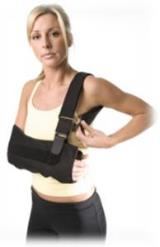Pain control after shoulder surgery
 Some degree of discomfort is common after any surgical procedure. We will do our utmost to ensure you have as little discomfort as possible.
Some degree of discomfort is common after any surgical procedure. We will do our utmost to ensure you have as little discomfort as possible.
Your surgeon and anaesthetist will discuss their preferred method of pain control with you prior to the surgery.
The following pain control methods are all commonly used in our practice:
- A local nerve block, known as an interscalene block
- Local anaesthetic injected into the area of surgery - intra-articular (into the joint) or into the wound (for open surgery)
- Viscoseal injected into your shoulder at the time of surgery
- Painkillers and Anti-inflammatory medications, taken regularly on discharge from hospital (see below)
- Cold compression therapy
Interscalene Block:
You may have had a nerve block for the surgery, known as an interscalene block (ISB). The anaesthetist will discuss this in detail with you before the surgery. After the operation the shoulder and arm may feel numb. This should last for about 12-24 hours . After this the shoulder may be sore and you will be given painkillers to help this whilst in hospital. These should be continued after you are discharged home. It is essential you take the painkillers before the nerve block has worn off.
To read more about interscalene blocks click here
After leaving the hospital, it is extremely important that you take regular pain killers at the prescribed times as soon as you get home. This is to avoid unpleasant pain when the nerve block begins to wear off (which can be in the middle of the night). Pain control is in the form of regular painkillers (combinations of paracetamol and codeine, such as cocodamol) and an anti-inflammatory (in the form of further daily Volterol patches or tablets). You should use both the painkiller and anti-inflammatory together, unless contra-indicated. Please check with the hospital staff that you are able to safely take these tablets.
- Paracetamol (500mgs)
This drug belongs to a group of medicines known as analgesics (painkillers). It is the first choice painkiller as it works well and rarely causes side effects.
Adults should take two tables four times a day.
Do not take more than 8 tablets in any 24 hour period. Do not take other medicines containing Paracetamol. - Diclofenac (50mgs)
This belongs to a group of drugs known as non-steroidal anti-inflammatory drugs (NSAIDs). They act on the chemicals produced by damaged cells that cause inflammation in tissue and nerves. They come in 50mg tablets.
Take 50mg three times per day. Do not take more than 150mgs in any 24 hour period. If you have a stomach ulcer, or are taking aspirin or anticoagulants, consult your doctor before taking Diclofenac.
Side effects: stomach ache, cramps, headaches, breathing difficulties, bruising, dizziness. - Diclofenac and Paracetamol should be taken together for effective pain relief after surgery.
If your pain is more severe, you may be given medicines such as Cocodamol or Tramadol .
Cold Compression Therapy:
Ice packs can be used to reduce swelling and control pain. Wrap frozen peas or crushed ice in a damp, cold cloth and place on the shoulder for up to 15 minutes. In order to maintain a dry wound, cover the dressing / wound with some cling film before applying the ice pack, alternatively you may be given waterproof dressings by the hospital.
| NOTE: If the painkillers are insufficient that you have been given from the hospital, please contact the hospital ward or your GP. |
Other Methods we use:
Cold compression therapy :
A Cold compression cuff, which aids with pain control and reducing swelling can be used instead of ice packs.
Volterol Patch:
You may also have a Volterol patch on your shoulder after the operation. This provides a controlled, slow release of diclofenac, which is an anti-inflammatory. The patch will last for 24 hours, providing pain relief as the nerve block wears off. You will be given a 5 day supply (instead of tablets) and you must change it every 24 hours. Please check with the hospital staff that you are able to safely use the patches.
For more information click here


